Slack and Company
When it comes to creating work environments where people want to be, and where they can do their best work, even the smallest details make a difference.
Chicago, Illinois, US
Download PDF (442.6 KB)
A walk through Millennium Park, a long ride on a commuter train, a stunning view of the skyline: inspiration can come from anywhere, especially for the creative team at Slack and Company, a business-to-business marketing firm with a window-lined office perched high above the Chicago River.
Early in the morning, company founder Gary Slack often finds himself, coffee in hand, looking out over the boats cruising past the buildings and bridges along the river. It’s a moment to celebrate what a tremendous, creativity-inspiring gift the cityscape is to his team of graphic and digital designers, copywriters, strategists and art directors. It’s also an important reminder of just how much an environment can affect a person’s perspective on work and on the organisation that employs them.
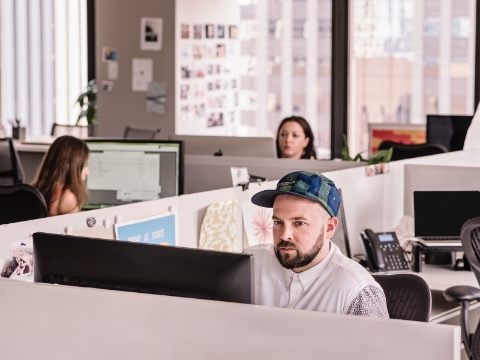
Canvas Office Landscape workstations with low screens give people the privacy they need to focus and help them stay connected to others working nearby.
“Every window has a great view, and it’s a great way to be inspired,” says Slack. “It’s something our employees – my co-workers – really appreciate, because it helps enhance the sense that they’re in an elevated, high-quality work environment.”
Creating an optimal experience of work for his people is something Slack cares about greatly. In fact, he’s forgone the typical Chief Executive Officer moniker for the title of Chief Experience Officer – a label that is perhaps more apropos to the employee-centric method of running the business.
“The way I look at it, every morning, everyone makes a choice to go back to the place that employs them,” says Slack. “So my goal is when people wake up, they can’t wait to get into the office.”
In the not-so-distant past, the offices of Slack and Company weren’t working as hard as they could to get people excited about coming into the office every day – a major issue for a company whose creative output relies on colleagues working together to conceive ideas, refine strategy and launch campaigns. Confined to high-walled cubicles with little space to tack up notes and share ideas, Slack’s creative team members were struggling to connect.
“In our old space, we would wear headphones and instant message each other a lot,” says Elisa Ivany, a Creative Director at Slack. “When we needed to meet, we would have to book a closed-off conference room.”
This lack of connection spilled over into the employees’ relationship with leadership, too. “I had my own office before,” says Ron Klingensmith, Chief Creative Officer. “It afforded me some privacy, but it also created a bit of a barrier to my creative team.”
All of these physical and social impediments were taking a toll on engagement and creative output, and making it difficult for Slack and Company to establish itself as a firm that’s dedicated both to strategic thinking and superior design. It was also keeping them from reaching strategic business goals, including increasing efficiency and promoting knowledge-sharing among employees. That’s why Gary Slack made the decision to expand the company’s headquarters into a neighbouring 167 m2 space, and enlist Chicago-based A&D firm Gensler and Herman Miller to help.
“When we started this project, we wanted to increase the espirit de corps. The pride people have in coming here every day,” says Slack. “We also wanted to increase productivity and efficiency, and, maybe, most importantly, improve the quality of our thinking, our creative product, and elevate it in such a way that our clients would notice, and that prospective clients would be more likely to hire us.”
During the course of the project, Slack found himself drawn to Living Office, Herman Miller’s point-of-view on people, work and the workplace. Informed by Living Office insights, organisations can work with their design partners to create high-performing workplaces that elevate the experience of work for people, and help businesses achieve their goals.
“I think the story behind Living Office is not only about how an office can perform as a whole, but how you can break down an environment and make each individual within that space successful in what they do,” says Sheryl Schulze, a Senior Project Director at Gensler.
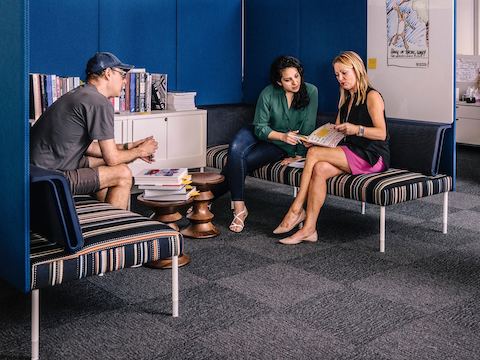
And for members of the creative team at Slack and Company to be successful, they needed to be able to easily move between individual tasks, quick chats with colleagues, impromptu brainstorming sessions, and more formal gatherings to review concepts for client campaigns.
“What we’ve been able to do in the new space is have flexible lounge furniture, where you can either pull up a couple of chairs very easily and have a conversation with a colleague,” says Schulze. “Or you can have a client come in and have a very immersive session where you can pull a number of mobile whiteboards around.”
In addition to a highly flexible workplace, the Slack team now has a variety of settings where they can work and meet – all purposefully designed and arranged based on the Living Office framework for understanding people, the work they do, and the tools and furnishings they need to succeed.
A bright, open Plaza Setting near the reception desk anchors Slack’s workplace. “It’s definitely the heart of the space,” says Kilngensmith. “We have a big screen on the wall, and we’ve already used it for a couple of workshops for our clients. It’s also warm and inviting, and it brings together people from both sides of the office.” When people do get together in this space, they share meals, work together on campaigns and socialise. “Usually at about three o’clock, people go to the Plaza to work for the rest of the day,” says Ivany. “It’s nice and open, and it’s full of light.”
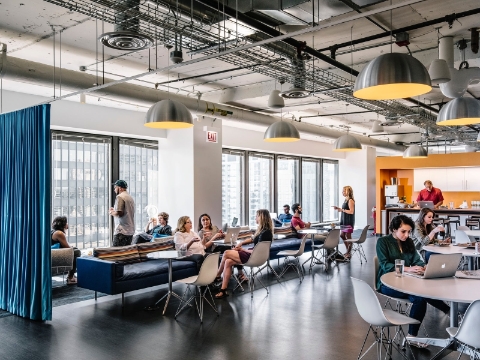
From small, semi-enclosed settings for group work to a large, light-filled Plaza, Slack employees have a choice of spaces where they can work, meet or socialise.
The new additions to Slack’s workplace are bringing people together in other ways, too. In Cove and Workshops Settings lining the perimeter of the space, people can easily see and respond to each other’s work, displayed on notice boards and mobile whiteboards.
“You’d be amazed by all the people who are coming by to look at the work we’re now able to pin up on the walls,” says Klingensmith. “We call them ‘drive-bys’, where we leave the work up for an extended period of time so people can critique it. It helps us narrow things down and make decisions more quickly. A lot of efficiency is gained by this.”
Improvements in efficiency and knowledge-sharing among team members and between leadership and staff have followed a parallel path, mainly due to the openness of the new space, enabled by Canvas Office Landscape workstations with low screens separating each space.
“Now that I sit with my team, I’m able to pop over to someone and have a quick conversation,” says Klingensmith. “I’m in tune more with what’s going on in the department because I’m able to overhear conversations, and we can troubleshoot and solve problems together. It’s opened up the opportunity for me to get really close to my team, push them, and make the work a lot better.”
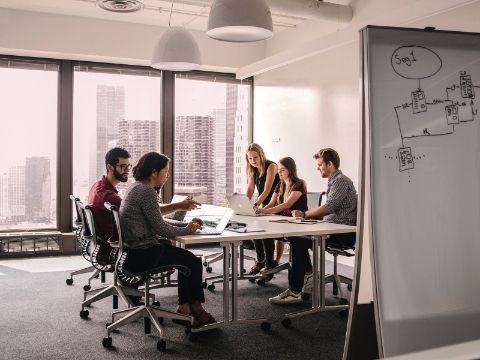
With more spaces to work together away from individual workstations, people are able to work together more efficiently without distracting others.
Perhaps most importantly, Slack and Company has been able to make all of these work-improving, business-enhancing gains while maintaining the unique – even quirky – character of the company.
“One of the goals for this project was to create an environment that allows for flexibility, not just in the types of work being done and the places where people can work, but also in the way people can personalise their space,” says Schulze. “The only rule is to be yourself. This is not a museum. It’s an environment that’s meant to be celebrated and lived in.”
Celebratory bursts of life can be found throughout the space – from an enormous pink gorilla dangling from the rafters, to accent pillows emblazoned with the visages of Mr. T and Patrick Swayze, to a life-sized cutout of Marilyn Monroe that watches over one of the graphic designers as she works at her desk. These whimsical elements are juxtaposed with colourful Eames Shell Chairs, elegant Wireframe Sofas and Spun Chairs where people can sit, spin and have a little fun while they work.
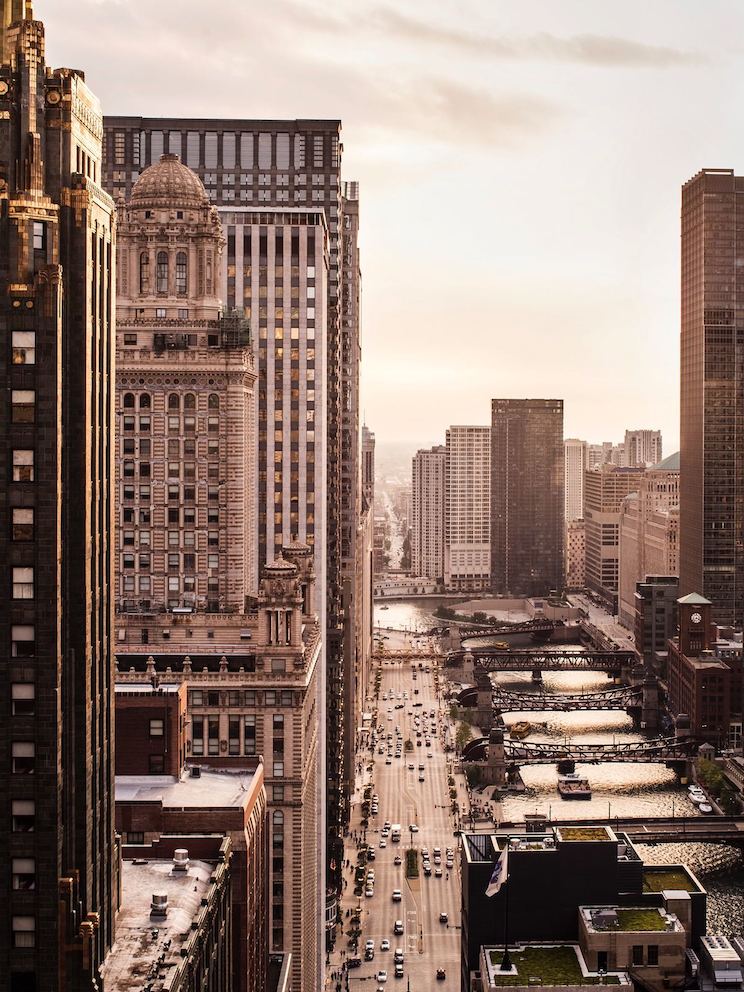
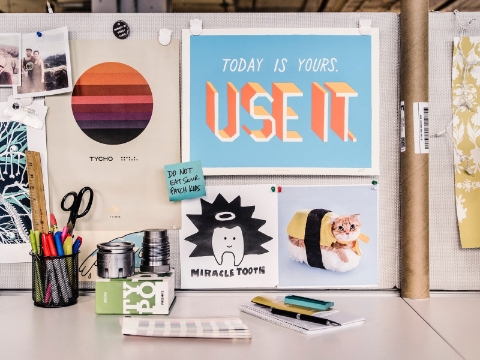
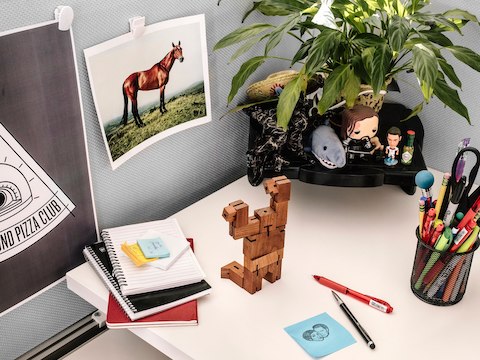
Details inside and outside the space are a testament to who the people at Slack and Company are: a Chicago-based business-to-business marketing firm that values creativity and strategic thinking above all else.
Wrapped in the breathtaking package of the Chicago skyline, this thoughtful and expressive Living Office workplace allows Slack and Company’s personality to pop to all who enter the space, with the added – and perhaps even more important – benefit of creating a beautifully appointed, highly supportive space where people want to come to work every day.
“The whole concept of Living Office is about enabling a company – a culture – to be higher performing, and to elevate the pride and joy that people have spending time at the office every day,” says Slack. “The combination of what we look at outside – the vibrancy and the people and the cars and the hubbub – and what’s going on inside the office makes for a spectacular workplace where we can do great work and have fun doing it.”